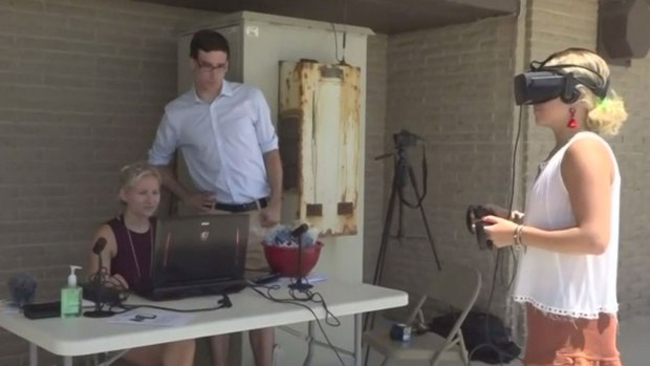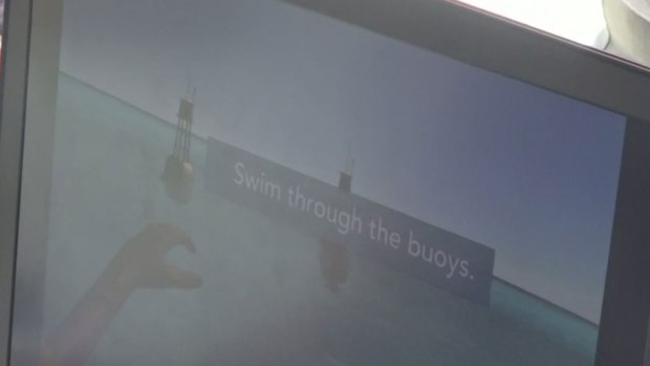NOTE: This Hofstra University rip currents study, which uses virtual reality as its platform to educate beachgoers, is funded by New York Sea Grant.
—By Briella Tomassetti, FOX 5 NY
Point Lookout, NY, July 16, 2019 - As Long Islanders flock to the shore this summer, Hofstra University is helping beachgoers learn the basics of rip current safety before they get in the water.
"It's surprising how little some people do know about beach safety and rip currents," said Antoinette Montes, a Hofstra student researcher.
Researchers like Montes and Jase Bernhardt, an assistant professor at Hofstra University, are swapping the traditional classroom setting for brand-new virtual reality equipment to immerse the user into an ocean simulation. The person wearing the goggles becomes the swimmer.
Rip currents kill more than 100 people nationwide every year and account for more than 80% of lifeguard rescues, according to the United States Lifesaving Association. Experts say the main reason for that is not knowing how to get out of one.
"Rip currents themselves actually will not pull you under," Bernhardt said. "But what might happen is, especially if you're a weaker swimmer or get very nervous and scared, you'll fight the rip current and try to go back towards shore."
However, as we learned in the simulation, the correct way to safely navigate out of a rip current is by swimming parallel to shore.
Hofstra University received $11,000 towards the purchase of two sets of virtual reality equipment through the New York Sea Grant program. Bernhardt hopes the project will grasp the attention of the younger generation and bring more awareness to beach safety.
On Air: Professor Hoping To Save Lives With Rip Current Virtual Reality Simulator
—By Dick Brennan, CBS 2 New Yok
Point Lookout, NY, July 16, 2019 - Virtual reality could help save real lives on the beach.
Swimming out of rip current can sometimes be easier said than done, but virtual reality at the beach is helping people experience that first hand, safely, CBS2’s Dick Brennan reports.
“I feel like I’m in it,” Sabina Goldstein, 28, said.
Goldstein has lived on Long Island her whole life, but the avid beach-goer admits she had no idea how to escape a rip current.
“I went to, like, camp growing up and I had swimming lessons and everything, and I never knew this,” she said.
Now, thanks to virtual reality, the Merrick woman is primed for whatever comes her way while swimming in the ocean.

A virtual reality program simulates what it’s like to be caught in a rip current. Credit: CBS2.
“You never know when it’ll happen,” she said.
Just a few weeks after a woman died in a rip current off of Fire Island, Dr. Jase Bernhardt and his team have set up a virtual reality experience at Point Lookout beach, using technology to simulate what it’s like to get caught in a rip current.
“Rip currents typically on the Atlantic beaches around New York, there’s one or even multiple rip current fatalities in most given beach seasons, and many throughout the U.S., sometimes 50-100 in a given year, and obviously this is just very easily preventable,” Bernhardt said.
Two years ago, the Hofstra University professor used similar technology to simulate how it feels to get caught in a hurricane.
“We found that those who saw the VR simulation of the hurricane were more likely to take warnings seriously and take what we think, as meteorologists, are the proper actions,” he said.
By wearing a headset and using joysticks, participants learn to safely swim parallel with the beach until they’re free from the rip current. The simulator also reminds people not to panic and to signal for help from a lifeguard.
“It’s a good way to put yourself in a situation where you might need saving without actually being put in danger,” Zach Neman said.
“Some unsafe swimmers, who know what can happen out there?” Natalie Ferretti said.

A virtual reality program simulates what it’s like to be caught in a rip current. Credit: CBS2.
After each simulation, the findings are recorded and reviewed, so the team could come back next year with a better understanding and a new reality.
The simulation will be set up at Point Lookout beach every Tuesday and Thursday until the end of the summer. They also plan on taking the technology to the Hamptons.
More Info: New York Sea Grant
New York Sea Grant (NYSG), a cooperative program of Cornell University
and the State University of New York (SUNY), is one of 33 university-based
programs under the National Oceanic and Atmospheric Administration’s
National Sea Grant College Program.
Since 1971, NYSG has represented a statewide network of integrated
research, education and extension services promoting coastal community
economic vitality, environmental sustainability and citizen awareness
and understanding about the State’s marine and Great Lakes resources.
Through NYSG’s efforts, the combined talents of university scientists
and extension specialists help develop and transfer science-based
information to many coastal user groups—businesses and industries,
federal, state and local government decision-makers and agency managers,
educators, the media and the interested public.
The program maintains Great Lakes offices at Cornell University, SUNY
Buffalo, SUNY Oswego and the Wayne County Cooperative Extension office
in Newark. In the State's marine waters, NYSG has offices at Stony Brook
University in Long Island, Brooklyn College and Cornell Cooperative
Extension in NYC and Kingston in the Hudson Valley.
For updates on Sea Grant activities: www.nyseagrant.org has RSS, Facebook, Twitter, and YouTube links. NYSG offers a free e-list sign up via www.nyseagrant.org/nycoastlines for its flagship publication, NY Coastlines/Currents, which is published quarterly. Our program also produces an occasional e-newsletter,"NOAA Sea Grant's Social Media Review," via its blog, www.nyseagrant.org/blog.